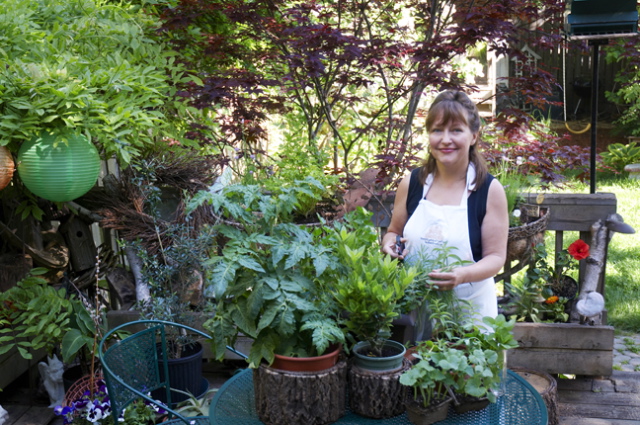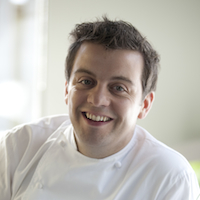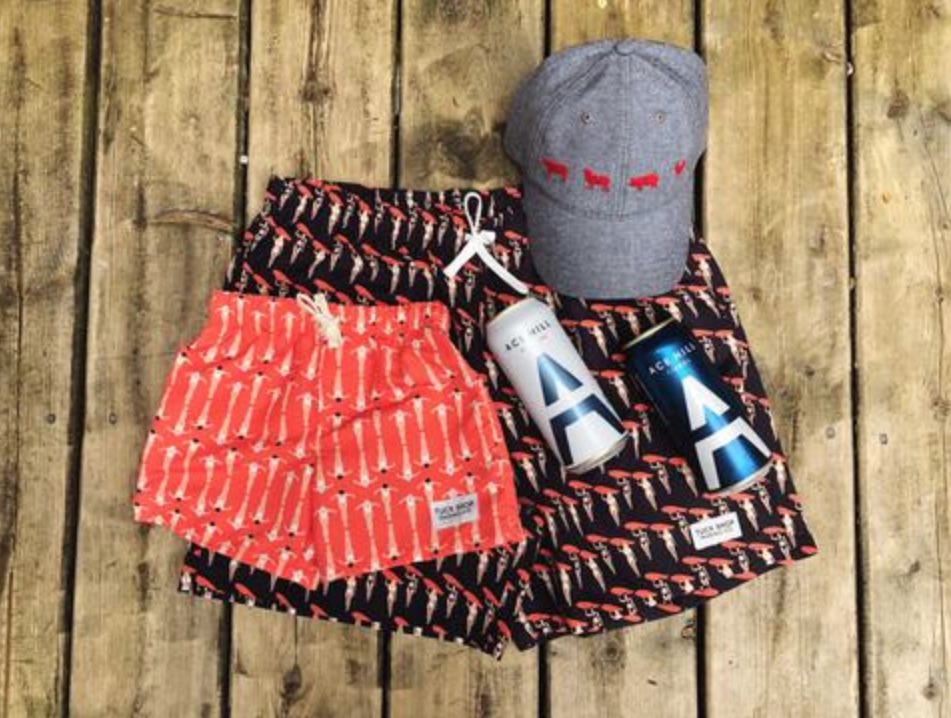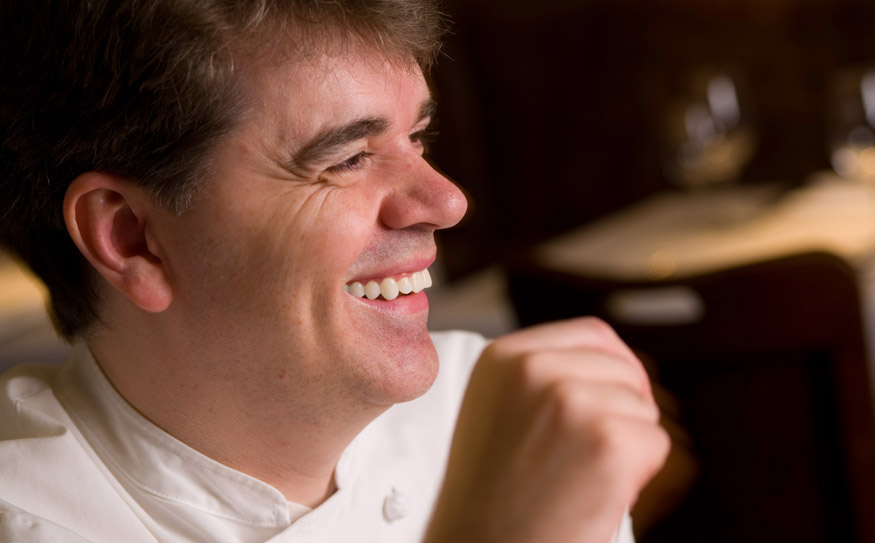by Alexandra Brown

Veteran Canadian food stylist Olga Truchan in her garden, May 2010. Photo: David Scott
Canadian food stylist, Olga Truchan, has been “playing with food” for as long as she can remember. “I’ve always played with food, even as a little girl I was making smiley faces in my peanut butter,” she said. I recently sat down in Toronto with Olga to discuss how food styling has changed in the 33 years since she entered the business after graduating from Ryerson in 1977 with a Science degree in Food and Human Nutrition.
Olga chose the program at Ryerson because she wanted to take the Food Photography option in third and fourth years, which was ironically dropped as a course the year she started the program. “I stayed in the program anyway,” she said, “and just developed my own food photography portfolio by working with friends in the photography program. From there, I made cold calls to people, asking them to give me a chance.”
Olga’s first break came as the food stylist’s assistant on a Knox Gelatin booklet, quickly followed by successive projects for Kraft Foods. She worked with many different photographers in Toronto, in what she describes as a “great assembly-line of food production, day in and day out,” where she learned how to cook in that fast-paced environment, how to prepare food for photography, how to solve problems… and there were many, all in order to Make it Right for the product shot. “The 60’s and 70’s were all about clean, not real, beauty food shots. Everything had to be absolutely perfect. There were very few garnishes and no crumbs. Curly parsley, not even Italian parsley, was about the only flourish used.” During the decade, magazines like Gourmet ruled the presentation of food in photography in North America. Huge spreads, and artful arrangements with numerous molds and aspics, presented food “on a pedestal”, but, in reality, Olga feels, was unattainable for the everyday household.
In the late 70’s, interesting things started to happen with food because of the era and the influx of immigration, Olga says. People also started to think about the health conscious aspects of food. Alice Waters in California was one of the first people to drive the local food movement. Olga deems the 80’s as the beginning of a food revolution. “The focus moved away from Britain and France,” she said. “People in North America were discovering their roots, the food of their heritage, the food their grandmothers cooked. Spices, herbs, garlic – garlic! started to enter our vocabularies. It was a highly experimental time.” During the 80’s, food photography was freed from rules, and images became full, intense flavours, often with black, and red and shiny surfaces, and heavily saturated colours being used as backgrounds and accessories. Many garnishes were used.
During this period, food stylists gained increasing freedom and importance, since their knowledge was critical to authentic presentation, how certain foods were to be served, or not served, so as to adhere correctly to cultural traditions. “I did a lot of research in those days,” Olga said. “For example, I had to know the difference between different chopsticks to make sure we would use the correct ones when presenting different dishes from different Asian cultures … not to cross them, not to stick them in the food like rabbit ears (it’s rude).” Fads started, some silly, some contrived, and most faded away. nouvelle cuisine and ‘light food’ began, as did fusion. Less cream, more heart healthy. Publications such as Cuisine, Sphere, Food & Wine, Bon Appétit, as well as Gourmet, became increasingly important. In Canada’s media centre, Toronto, magazines like Epicure, Canadian Living, Homemaker’s and Chatelaine started to present different cuisines in their recipe pages. Restaurants in Toronto proliferated. “People were also travelling more, and wanted the food they ate while away reflected in their magazines.” During this time, Olga was also travelling, taking courses all around the world to hone her skills, from the Ritz in Paris to Thai cooking schools in Bangkok. She worked for “all the Boards” – Beef, Pork, Turkey, Egg, the Dairy Farmers, and styled food for television, print, billboards, and magazines. Her client roster had grown to include Foodland Ontario, General Foods, Dominion, Loblaw’s, Häagen Dazs, Breyers, McCain’s, Knorr, LCBO Food + Drink, Canadian Living and numerous other clients, magazines and calendars. She has worked with great food writers and chefs for their cookbooks like Bonnie Stern, Anne Lindsay, Anita Stewart, and Elizabeth Baird. Her longest-standing project has been the annual Milk Calendar, now having worked on it for 30 years.
During the 90’s, Olga saw a change from the contrived, sometimes over-the-top artfulness of the 80’s to a softer, more homey approach. Colours were very earthy and from nature. It was contemporary country. “Cocooning was the rage and, with it, food was much more approachable, with a ‘yes, you can do it yourself’ mentality starting to take hold. Martha Stewart was very influential in this era.” Saveur magazine began with authentic food …no pretence. The LCBO’s Food + Drink and President’s Choice magazines started. Chefs were becoming exalted, starting to take on star status. People were becoming foodies, food choice was expanding through the springing up of local farmers’ markets, and even more interesting cultural cuisines entering the restaurant scene. “My work with food in Canada is very natural,” Olga says. “There isn’t a lot of fake food and things covered in glue.” The food is real, but there are tricks to keeping food looking hot and fresh for hours. Vegetable oil on green beans to make them look hot, and make it glisten…. water keeps ham pink and beef moist and pink, not grey or black. Her dental tools serve her well for the fine art of arranging and re-arranging and detailing different foods. Olga’s food sourcing for production shoots was also becoming easier during the 90’s. “It used to be that one or two stores would carry the kind of mushrooms I needed, and I’d drive across the city or into the country for them. Now, Toronto has a wealth of stores, farmers’ markets and restaurants with food from all over the world making things so much more accessible, not just for me, but for everyone.” The 90’s was all about an abundance of really fresh veggies and fruits. And colour. Food styling during this time was all about colour and lots of garnishes: “Garnishes on the rims of the plates, architectural stacks … mile high food”.
In the 2000’s, Olga says that television has made food a spectator sport. People easily declare their love of food, of eating, of cooking. Food and wine became regular cocktail party chatter. Food websites sprang up. Donna Hay from Australia, had a great effect on food photography. Local is more important. There’s more white backgrounds used in photography, the food is the star, but not over-promised. “It’s like high-end peasant food,” she says. “Everything is being used, no waste, and food isn’t as quick as it used to be. It’s the ‘slow food’ movement away from fast, fast food. “Now, it’s all about real food, real ingredients, knowing where your food comes from.” That translates into minimal food photography, with fresh garnishes that are integral to the dish. Over the decades, Olga has discovered her favourite foods to prepare. Anything with great colour and texture. “Real fresh food, are my best subjects,” she says. Foods with a lot of little ingredients mixed together are harder to do, “It’s harder to make a frozen cheese lasagne look as delicious as a beautiful fruit dessert ,” she says.
For the coming decade, Olga sees a return to colour, with ‘real food’ continuing and strengthening its reign. New and different cultural food experiences will thrust interesting taste sensations our way. Appetite appeal in food photography is paramount, and incredible attention to small details will make, or break, a successful, and authentic, food shot. Olga says a food stylist’s job is to make you hear the sizzle, even if you can’t. “It’s a team effort to produce great food photography,” she says. “The photographer, prop stylist, art director, and food stylist – all people who should be like-minded, with a cohesive vision of the food, they are the ones that will produce successful work.”
 Alexandra Brown is a media and communications executive whose love of writing might only be surpassed by her love of good food. Find out more at alexb.ca.
Alexandra Brown is a media and communications executive whose love of writing might only be surpassed by her love of good food. Find out more at alexb.ca.








Trackbacks/Pingbacks